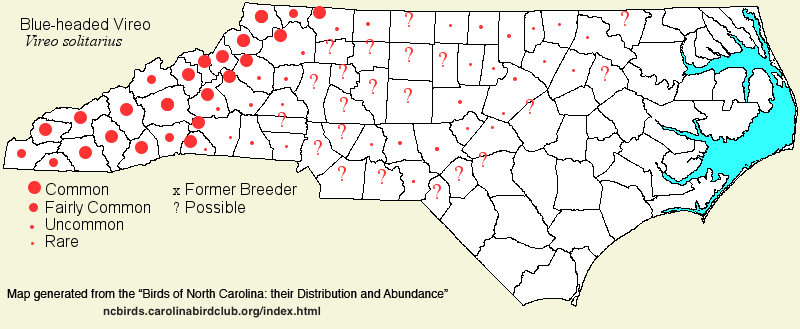 |  |
|
Blue-headed Vireo - Vireo solitarius VIREONIDAE Members: | Search Common: Search Scientific: |
|
|
|||||||
| General Comments | Long known as the Blue-headed Vireo, in the 1970's its name was changed to Solitary Vireo, for no obvious reasons -- most vireos are somewhat solitary -- other than its scientific name is "solitarius". In the early 2000's, the American Ornithologists' Union decided to split the Solitary Vireo into three species -- the Cassin's and Plumbeous in the Western part of the continent, and the Blue-headed Vireo for the former subspecies that nests in the Eastern states. The Blue-headed Vireo is a good name, as its head is a bluish-slate in color. It nests primarily in the spruce-fir zone in the East, extending southward from the Northeastern states mainly in the Appalachians. However, since the 1960's, the species has nested in the Piedmont and extreme western Coastal Plain (including the Sandhills). It and the White-eyed are the only vireos that regularly winter in the Southeast, being limited in North Carolina at that season to the Coastal Plain. For parts of the state, it is found only in migration. Breeding habitat is quite varied, but it favors mixed or coniferous forests (spruce, fir, hemlock, White Pine, and even Loblolly and Longleaf Pine) in upland situations. Wintering individuals favor maritime forests and other forests and woodlands with an evergreen canopy (Longleaf Pines, Live Oak stands, etc.). In winter, it joins mixed species flocks -- chickadees, titmice, nuthatches, warblers, etc. -- and is seldom found away from flocks. | ||||||
| Breeding Status | Breeder | ||||||
| NC BRC List | Definitive | ||||||
| State Status | |||||||
| U.S. Status | |||||||
| State Rank | S5B,S3N | ||||||
| Global Rank | G5 | ||||||
| Coastal Plain | Primarily a transient and winter resident; sparse breeder. In the nesting season, rare to uncommon in the Sandhills, and very rare along the Fall Line in the northwestern part of the region. In winter, fairly common along the southern coast, uncommon to fairly common along the central coast, and uncommon along the Outer Banks (except fairly common in Buxton Woods), in the Tidewater zone, and in the Sandhills; rare to uncommon over most of the inland portions. Generally uncommon in migration. Migrants and winter residents generally occur from mid-Oct to mid-Apr. Peak counts: breeding season -- 6 singing males, Fort Bragg (Hoke), 8 Jun 2022. Peak in winter: 31, Mattamuskeet NWR, 29 Dec 2022. | ||||||
| Piedmont | Primarily a transient, but also a summer resident in parts of the region, and a sparse winter visitor. As a breeder, generally uncommon in pine forests in the northeastern portions (Rockingham east to Halifax, and south to Moore and Stanly); also an uncommon breeder in most foothill ranges, such as the Brushy Mountains and the South Mountains; seemingly absent in most of the central third of the province. Uncommon to fairly common transient over the region. In winter, rare to uncommon in the extreme eastern portions, and rare westward, in Dec, but very few overwinter (quite rare by early Feb). Mostly from mid-Mar into Nov. Peak counts: | ||||||
| Mountains | Summer resident. Breeds essentially at all elevation levels, though more numerous (common) above 3,000 feet; fairly common to locally common below 3,000 feet. Mainly late Mar to mid- or late Oct. Peak counts: | ||||||
| Finding Tips |
The species is easily found in spring and summer in the mountains. Driving the Blue Ridge Parkway and pulling off at overlooks will certainly yield them after a few stops. **** | ||||||
| Attribution | LeGrand[2023-05-19], LeGrand[2023-03-24], LeGrand[2022-12-23] | ||||||
| NC Map Map depicts all counties with a report (transient or resident) for the species. | Click on county for list of all known species. |
| NC Breeding Season Map Map depicts assumed breeding season abundance for the species. |  |